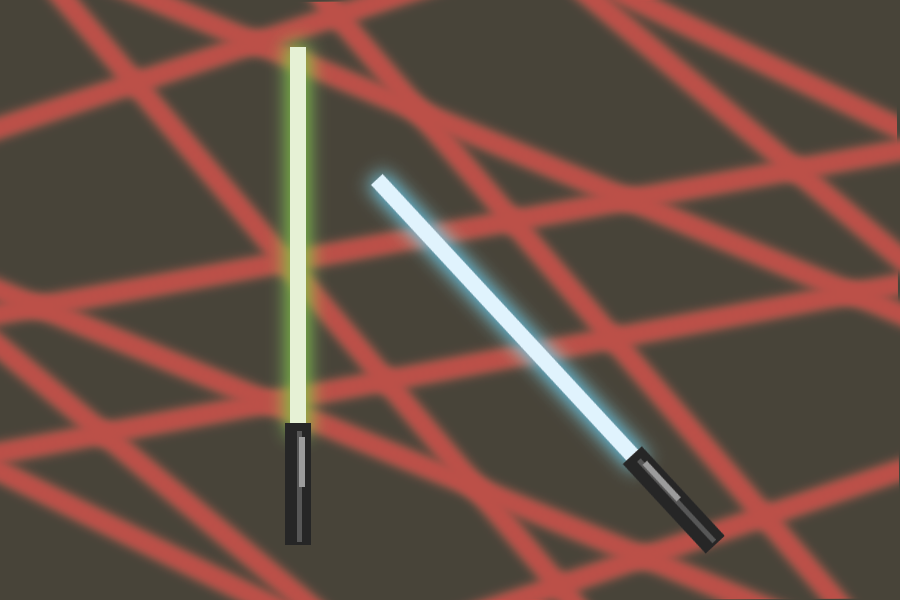
The science of lasers, molecular research, community outreach
Throw away those blasters, lightsabers and pop culture interpretations of the futuristic laser, because UC Davis professors are bringing the space-age laser to the present through their exciting research done on campus.
The UC Davis Chemistry Department sponsored a free showing of “Star Wars: The Force Awakens” on Feb. 25 in Rock Hall. Before the movie, Kyle Crabtree, an assistant professor in the UC Davis Chemistry Department, spoke briefly about the reality behind lasers as opposed to their various depictions in pop culture.
Crabtree mentioned that events like the “Star Wars” screening have the ability to expose the broader public to the reality of modern science. He emphasized the importance of having a scientifically literate society, and one way of achieving this is to host outreach events that combine larger cultural interests with specific topics in science.
“We value a scientifically literate public and now the science presence in popular entertainment media, like ‘Star Wars,’ is for entertainment purposes, not for educational purposes,” Crabtree said. “But since many people are familiar with the ideas in popular media, we wanted to see about using that as a jumping off point to give a fun, informative talk about science and technology.”
Crabtree studies astrochemistry, specifically chemical reactions in space, using lasers to examine the rates of chemical reactions in space-like environments.
“I use an excimer laser, an ultraviolet laser, it takes a pulse of ultraviolet laser radiation and we use it to break apart a molecule into some fragments,” Crabtree said. “Then we use other microwave devices to watch those fragments undergo chemical reactions. We are trying to create a space-like environment in the lab and then crack apart some molecules using lasers.”
Crabtree focuses on regions in the universe where stars are made. This is an area in space that starts as a cluster of dust and particles. His lab recreates this atmosphere to study the chemical reactions that occur lightyears away.
“We try to study the chemistry that happens in these stellar nurseries and see how far we can track the chemistry and figure out [if] there are interesting molecules that might be relevant to life as we know,” Crabtree said.
Lasers were theorized by Einstein in the early twentieth century, but they were not invented until later in that century. They have since revolutionized the understanding of the universe.
“Our entire understanding of what atoms and molecules do have been enabled by lasers,” Crabtree said.
William M. Jackson, UC Davis’ distinguished researcher and professor emeritus, has lived the history of lasers through his prolific application of lasers in research. He is interested in what happens when molecules break apart and, similarly to Crabtree, he is focused on the molecules that are abundant in the universe.
Jackson was working at NASA when lasers became available to use in research. Lasers can be used to stimulate electrons; they create a controlled and directional quality to the electrons that was impossible before the invention of lasers.
“We can play tricks with lasers that we can not do with spontaneous emission [of electrons] mostly because there is not enough intensity to do it,” Jackson said.
Jackson’s lab is home to two lasers that are impressive in size and hooked up to a variety of pumps, gadgets and are part of an intense sequence of mirrors, tubes and a mass spectrometer. Jackson uses this setup to measure the velocity of individual modules.
“We use one laser, oriented to break it apart, [and] we let it fly through a time of flight mass spectrometer to measure its velocity […] [then] we have to ionize it with another laser,” Jackson said.
Jackson studies nitric oxide, dioxide and carbon dioxide through this process.
Stephen Cramer, the advanced light source professor at UC Davis, focuses his research on enzymes that have clusters of iron and sulfur in them. Cramer uses x-rays to study the iron in the active sites of the enzymes, which he pairs with research focused around lasers.
“We have a sample [in the lab] and maybe something is bound to the metal, like carbon monoxide, and we take the laser and shine it on the sample and pop the carbon monoxide off,” Cramer said. “This process is called photolysis, [using it] we can measure the sample before and after the photolysis and see what has changed.”
The Star Wars screening brought awareness to lasers’ versatility and their integral role in understanding science at its most basic level.
“You need to get students emotionally excited about science, not just as some intellectual exercise, but something that you really care about,” Cramer said. “Science is hard, but if you’re excited about it […] you’re willing to put with the pain of working through the math or the late hours.”
Crabtree, Jackson and Cramer cover the spectrum of what can be studied through lasers, from the birthplace of stars to the velocity of individual molecules to metals in biology.
“Lasers are just one example of the interconnectedness of science […] chemistry and physics and lasers, it’s all connected whether you’re using the laser to read a barcode at the supermarket or measure gravity waves,” Cramer said.
Written by Emma Askea — science@theaggie.org



